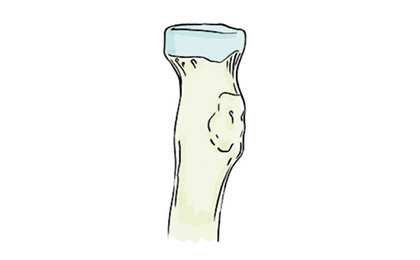Radial Head Fracture Treatment
Home > Condition & Treatment Map > Forearm Conditions & Treatments > Radial Head Fracture Treatment
Radial Head fractures are common injuries of the elbow. Most fractures will simply be a crack in the ‘head’ of the radius – the bone which helps as rotate the forearm.
Normal radial head
Cracked radial head
A simple crack in the bone, while painful, will normally heal well. Surgeons at Victorian Bone and Joint Specialists will assess the movement of the arm and will often advise treatment with a sling. Follow up x-rays maybe required.
If the broken bone has moved too far or if there is an inability to completely rotate the forearm then surgery to lock the bone back in place maybe the best option. Your surgeon at Victorian Bone and Joint Specialists will discuss this with you.
Fractured radial head fixed with screws
Once fixed, you may be able to begin to gentle move the elbow under the instruction of your surgeon. Placing weight through the arm will depend on the type of fracture you have and how it needed to be fixed.
Risks associated with surgery
As with all surgery, there are risks repairing fixing your Elbow fracture. These include infection, delayed healing or no healing of the bone. Difficulty with pain and range of movement may also be occur. Two important nerves, the radial and ulnar nerve, may be injured as a result of your injury or the surgery to fix it. Sometimes surgery to remove screws is required in the future. Removal of bone fragments may also be required. Arthritis of the elbow may occur as a result of this injury. There may be a need to replace the radial head with an artificial joint. This is normally due to the complexity of the fracture, your surgeon will discuss this with you.
Post-operative care
If you and your specialist decide that surgery is the best option for your elbow injury, you will stay in hospital overnight following your surgery and will be discharged the next day with pain relief to take for two to three of days as you need.
There will be a dressing over the surgical incision on the side of your elbow. You will have a bandage over the elbow and a sling. Sometimes a half cast is required to keep the elbow still.
You can move your fingers, wrist and shoulder straight away, but wear the sling provided for most of the day. The sling helps to take the weight of your arm to let the elbow rest.
After 2 weeks you will have an appointment with the team to have your wound checked, any stitches will be removed. Your trauma specialist will then give you advice on exercises and physiotherapy.
Physiotherapy can be helpful to get your elbow moving and strong again, but do not start this until you have had your appointment with your specialist at 2 weeks.
When to contact us
If you have any of these problems, please call the rooms on 03 5752 5020
Fever
Heavy bleeding or ooze from the wound
Increased swelling and redness around the surgery site
Pain in the calf muscles or difficulty breathing
There are risks with surgery. These include infection, delayed healing or no healing of the bone and there is an important nerve (radial nerve) which could be damaged either with your injury or surgery.




